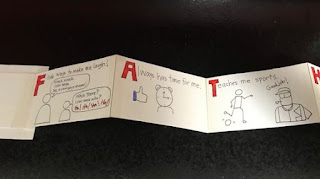We are almost finished the school year here in South Carolina and I have been sharing some of my favorite end of year class crafts with teachers.
The Accordion Foldable is one of my favorite for academic content (see my blog post using it in science) but for the end of the year I like to have students make a Father's Day version. Usually dad's get short changed on classroom crafts since Father's Day falls in June (June 16th this year) so this is my way of making it up to them 😉.
The supplies you will need:
- Eight 3 x 5 index cards (blank on both sides*)
- Two 4 x 6 index cards (blank on both sides*)
- Scotch Tape
- Glue (white glue or a hot glue gun)
- Pencil
- Think black sharpie
- Colored pencils/markers
- Optional: Envelopes (Staples carries photo envelopes that are 4 3/4 x 6 1/2)
*If you can't find the index cards you can cut down card stock paper to the sizes needed. These are typical index card sizes you just don't want the ones with the lines on one side.
The directions for putting it all together are outlined in the photo below 👇.
Below are close ups of my acrostic. I'm a terrible artist so I opened up The Noun Project website and searched for icons that matched what I was looking for and found ones I could duplicate freehand. I actually bought a $20/year Noun Project subscription because I make a lot of school flyers and it is nice to have the ability to use their icons without having to worry about copyright issues but I often use it for freehand drawing situations like this (I also direct students to the site for similar reasons).
If you make any with your students I would love to see them! Please post them on Twitter and tag me @atechcoachlife.





Comments